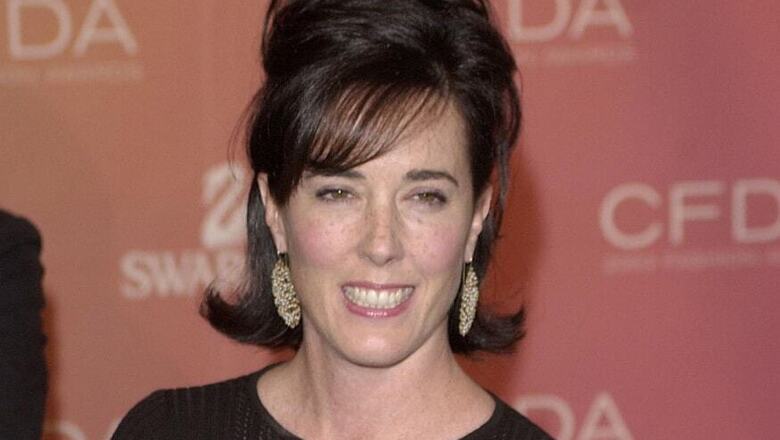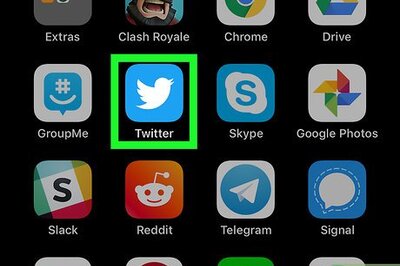
views
Bright. Vibrant. Colorful. And, most essentially, fun.
The same words used so often to describe Kate Spade’s enormously popular handbags — “It” bags that were both aspirational and affordable — were an apt description of the woman herself, say many in the fashion world. And that only contributed to the sense of shock and loss in the industry upon hearing the news Tuesday that Spade had apparently taken her own life at 55.
“She was always just as happy and delightful as her collection was,” said Fern Mallis, industry consultant and former director of the Council of Fashion Designers of America during Spade’s rise to success in the 1990s. “She was every bit the representation of that brand, and the fun of it all.”
Indeed, Spade had said it herself: “I hope that people remember me not just as a good businesswoman,” she told Glamour magazine in 2002, “but as a great friend — and a heck of a lot of fun.”
Spade was found hanged in the bedroom of her Park Avenue apartment Tuesday morning in an apparent suicide, law enforcement officials said.
Spade liked to say that she wasn’t obsessed with fashion, or interested in trends. She tried jeans, for example, decided they didn’t look good on her, and moved on. “I grew up in the Midwest, where you have to have (a fashion item) because you like it, not because you’re supposed to have it,” she told The AP in 2004. “It’s an adornment, not an obsession.”
And a Kate Spade bag was an adornment that was, crucially, affordable, unlike other iterations of “It” bags whose status seemed to hinge on the price tag. “It was a real shift,” Mallis said. “Everybody had Kate Spade bags. You could afford them, and happily buy more than one. They were affordable AND terrific AND fabulous.”
Having a Spade bag “was a sign that you were in the know,” said Eric Wilson, fashion news director at InStyle. “You associated yourself with this fun, cool, with-it, hip brand that wasn’t snobbish or so exclusive that it felt like a European luxury brand.”
And the bags seemed to effortlessly appeal to a variety of women. “She had a quirky visual language that captivated Bat Mitzvah girls and artists alike,” wrote actress Lena Dunham on Twitter. “She was also a staple of NYC who spread goodwill.”
Born Katherine Brosnahan, Spade grew up in Kansas City, Missouri. She was working as an accessories editor at Mademoiselle magazine when she launched her company with husband Andy in their New York apartment in 1993, based on six shapes of bags she thought every working woman needed. She called them her “stepping stones” — and said years later that they were still her favorites.
As her brand expanded, “the fun, colorful, bright designs she created added an element of cheerfulness others have tried to emulate,” said Deidra Arrington, associate professor of fashion design and merchandising at Virginia Commonwealth University. “She was a visionary.” One obvious measure of her influence was the number of counterfeit Kate Spade bags one could find on the streets, Arrington said. “Most women remember their first Kate Spade bag. I still have mine.”
Indeed, on social media, many women were recalling their first Spade bag. “My grandmother gave me my first Kate Spade bag when I was in college,” Chelsea Clinton wrote on Twitter. “I still have it.” Jenna Bush Hager wrote: “I will never forget the first Kate Spade bag I got for Christmas in college.”
Spade was not only about bags: she would expand into shoes, apparel, luggage and other accessories, and stationery. “Everyone loves to get a letter,” Spade told the AP in 2006, explaining that she never used computers and had her staff print out emails. “I love sending them. I love getting them.”
Spade, who won multiple CFDA awards and was named a “giant of design” by House Beautiful magazine, walked away from her company in 2007, a year after it was acquired from the Neiman Marcus Group for $125 million by the company then known as Liz Claiborne Inc.
Coach, now known as Tapestry, bought the Kate Spade brand last year for $2.4 billion. Spade and her husband — who is the brother of comedian David Spade — started a new handbag company recently, Frances Valentine.
Wilson, of InStyle, recalled often finding her in her store, helping shoppers. “Often I would walk in and I’d see her there serving customers, not telling them ‘I’m Kate Spade’ or Kate Valentine, her other alias, but just helping people,” he said. “I found her to be just down to earth, a normal mom, talking about the trials and tribulations of raising a child and life in the city.”
Mallis, the former CFDA director, noted that the stunning news of Spade’s death came just the morning after virtually the entire New York fashion industry had gathered at the Brooklyn Museum for the glitzy annual CFDA awards. “Nobody could have ever anticipated that the next day, this was the news that would be flashing on our phones,” she said. “You just never know the demons that people are dealing with.”
Outside a Kate Spade store on Manhattan’s Fifth Avenue Tuesday, Dorothy Ruderman, who said she was a fan of the designer, compared Spade’s death to that of Robin Williams, who hanged himself in 2014. “You see someone who kind of made a career off of making people smile,” she said. “It’s sad.”



















Comments
0 comment